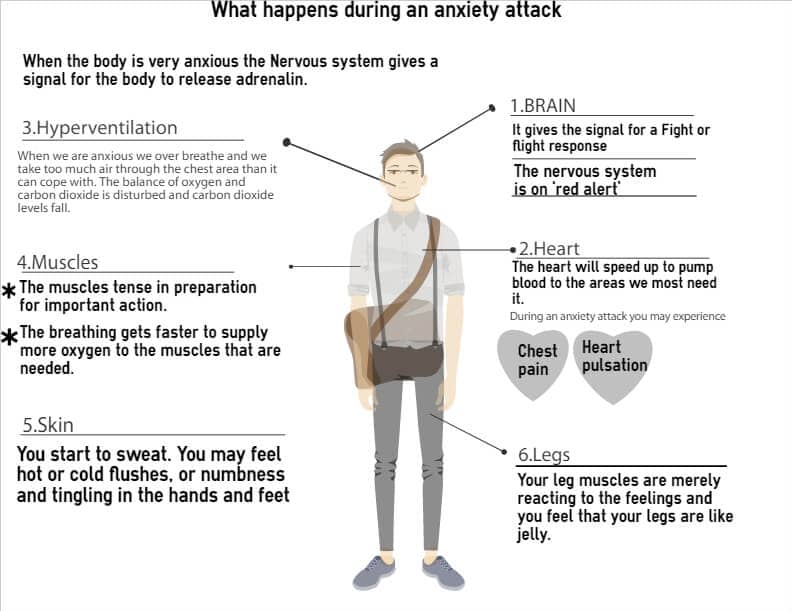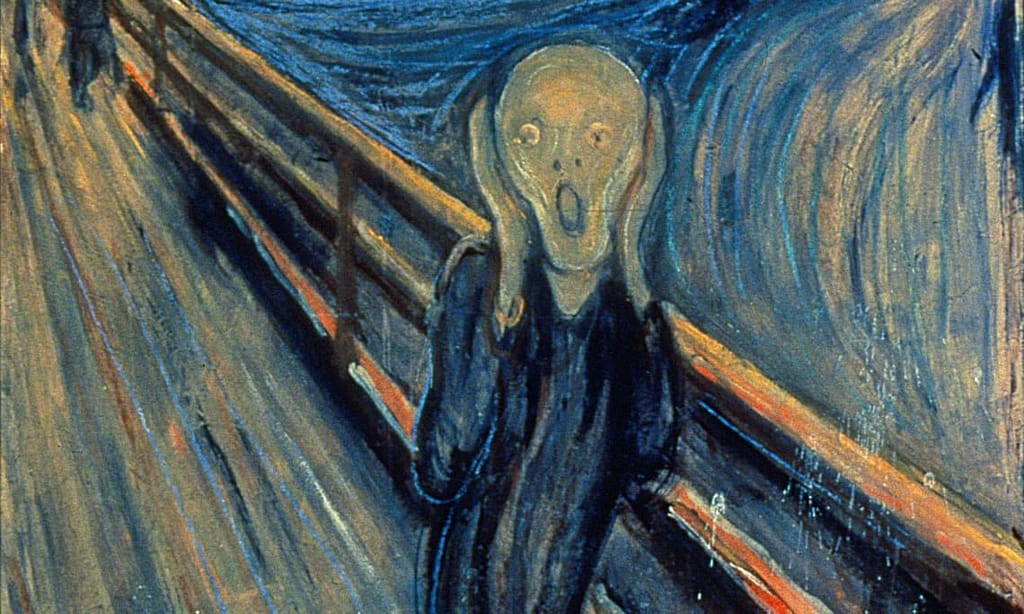Last Updated on February, 2023 by Edison
Here you’ll learn practical strategies to cope with anxiety.
Common Anxiety Symptoms
Anxiety is an undivided part of our life. We feel anxious before meeting our crush, giving a speech, going to the dentist, etc. That is normal. But if you experience these symptoms regularly, you need to see a psychologist.
Panic attacks are when you feel terrified and helpless and have a powerful urge to leave.
A panic attack is accompanied by difficulty breathing, a pounding or racing heart, feeling weak, hot or cold, chest pain, and sweating.
Usually, a panic attack lasts for a few minutes.

Causes of Anxiety Disorders
Anxiety results from a combination of several factors:
Genetic predisposition – Some people may have a genetic predisposition toward anxiety.
Personality traits – Research suggests that children with particular characteristics are more likely to develop anxiety than others.
Some traits are children who are easily concerned, inhibited, shy, or lack self-esteem.
Response to the challenge of adulthood – When people experience a period of high stress, such as feeling trapped in an awful job or relationship; change in living arrangements; the death of someone they love; having babies, etc.
A situation where stress starts accumulating to the point the person feels it is way too much.
People develop panic attacks in their twenties or thirties.
These factors have one thing in common:
They are not under your control.
So, there’s no reason for you to feel ashamed of suffering from anxiety.
It is your problem, not your fault.
Fight-Flight-Freeze
When you feel you are in danger, your brain has three options:
Fight – If it looks weaker than me, I’ll fight it.
Flight – If it looks stronger than me, I will run away.
Freeze – If it looks stronger and faster than me, I’ll freeze and hope it doesn’t do something.
Doctor David Carbonell from the website anxietycoach said:
“When people experience fear, panic attacks, or phobias, they instinctively treat it as a danger. They try to protect themselves with a variation of the fight, flight, freeze”.
When you feel anxiety, the brain gives the signal to the adrenal glands to produce hormones, adrenaline, and noradrenaline:
Adrenaline is the human fuel. It gives strength to the body to fight or run. It increases the heartbeat, and blood circulation, expanding the passages of the lungs.
Noradrenaline is the hormone of anger.
When we need these hormones, we burn them, and nothing happens.
But when they are produced just by thinking, the body wants to burn them and gives you anxiety symptoms.
Misconceptions about anxiety
First, people with anxiety never experience a heart attack.
During an anxiety attack, the body is preparing for a fight.
It fills all the vital organs, including the heart, with oxygenated blood.
This process makes a heart attack very unlikely to occur.
A normal heartbeat is 60-100 beats/minute, and the heart rate goes over 100 beats during an anxiety attack. This only shows that the heart is strong and healthy. So there’s no need to worry about it.
Second, people with anxiety tend to worry about going crazy.
No one with anxiety has ever gone mad.
Just because you realize that you have a panic attack shows you are not going crazy.
People who go crazy lose contact with reality, while anxious people are too much in touch with reality.
Third, what will other people think?
They worry that other people may think they are weird.
People around you don’t have a clue about what you are experiencing.
Fourth, many people with anxiety fear they will faint.
It is impossible to faint during a panic attack.
Again, your body is full of adrenaline, which gives you great energy.
Amygdala
The part of the brain that makes fight-flight decisions is the amygdala.
The amygdala works without conscious awareness.
Your amygdala is always watching for some danger. And when it sees one, true or false, it opens a flight-fight-freeze response and fills you with fear.
When the threat is real, that’s a good thing.
But sometimes, the amygdala will make a mistake by seeing danger when there isn’t.
It learns by practice.
When you run away from whatever danger is, the amygdala is watching.
Running away from a murderer is a good thing.
But if you run away from a grocery store, a dog, a clown, or any situation that makes you feel anxious, that is a bad thing.
Now your amygdala will see the supermarket, the dog, the clown, or similar situations as dangerous. It will make you afraid the next time you see one.
It means that when you avoid and stay away from what you fear, your amygdala will make the same mistakes. You are not giving it a chance to learn something new.
So you should train the amygdala to stop setting off the alarm.
You can do this by exposing yourself to a situation that makes you afraid.
Stretch the comfort zone
The best way to overcome a particular fear is by facing it.
You probably heard the expression, “get out of your comfort zone”.
Well, getting out of your comfort zone might be too much for you.
It would help if you stretched your comfort zone.
You start by doing something small that makes you uncomfortable. Then you do something else that is a little more uncomfortable. You gradually start increasing the difficulty level.
You’ll experience anxiety and probably panic attacks, but it’s crucial to keep doing what you planned.
I know it’s tough to handle the feeling of panic.
But think about it…
You are laying out the groundwork to overcome anxiety once and for all.
And as a bonus for your work, after you face fear, you’ll feel exhilarated.
Isn’t that worth it?
If you are reading this, I’m sure the answer is yes.
This exercise will allow the amygdala to learn that those situations you have been avoiding for months (even years) are not dangerous.
Always remember: Avoiding uncomfortable situations will give you tranquillity in the short term, but you are paying an enormous price in the long term.
10 Seconds
My psychologist taught me this trick to deal with panic attacks.
You can use it every time you feel nervous or uncomfortable.
Just breathe deeply, fill the chest with air, and hold it for 10 seconds.
Do it a few times until you feel comfortable again.
I know it sounds too easy to be true, but it works.
It fills the body with oxygen and forces the brain to focus on breathing rather than producing negative thoughts.
This trick helps you prevent a panic attack or calm down faster if you are experiencing one.
Practice holding your breath even if you aren’t nervous. The reason is that it will be easy for you to apply when you really need it.
Quick Tips to Manage Anxiety
— The most important advice I can give you is to consult an experienced psychologist. They will help you better understand yourself and motivate you to act.
— Decide you will give your best to overcome anxiety no matter how many challenges you face.
Say, “It’s time to stop living like this.”
— Redirect the attention. When you feel anxiety is kicking in, redirect your attention to something else. Try to engage more in the conversation or notice the outside world if you are alone.
— Fear is the goblin that protects the treasure. You need to use fear as a compass. Does a particular situation make you feel anxious? Then face it.
Show your amygdala there is nothing to be afraid of.
— Your goal is not to do what you want but what you need.
— Don’t wait until you feel confident to act. It doesn’t work that way. You need to act then fear will diminish.
— Emotions are temporary. Don’t give them too much importance.
— Even when you do things you couldn’t do before, you shouldn’t stop. You need to keep challenging yourself. You need to raise your standards.
— If you experience a panic attack, keep going. Don’t sabotage yourself by going to “safety.”
— You Are Tougher Than You Think.
– You need to show pragmatism. Does this thought, emotion, or event help me achieve the goal? If yes, then everything it’s cool. If not, I show indifference toward it.
Sources:
“The Confidence Gap” by Dr Russ Harris
“The Self-confidence workbook” by Barbara Markway, PhD



